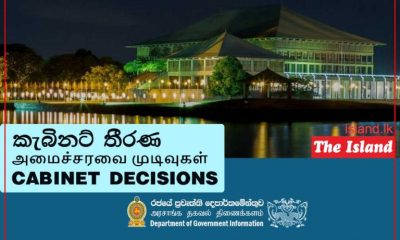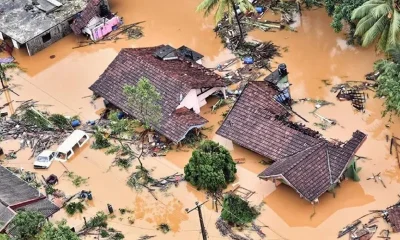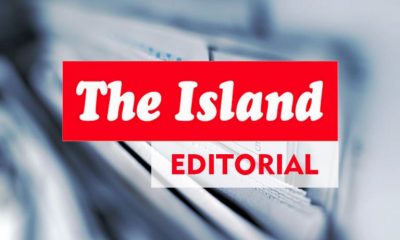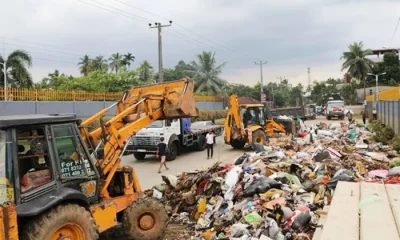Business
NDB posts solid performance in H1 2021 amidst the pandemic

National Development Bank PLC, Sri Lanka’s fourth largest listed bank continued to demonstrate its resilience to external shocks and ability to deliver consistent results, as reflected in financial statements released to the Colombo Stock Exchange for the six months ended 30 June 2021, the bank said in a news release last week.
The review period was marked by month long travel restrictions imposed to curb the spread of the third wave of the pandemic in Sri Lanka which affected business momentum. NDB’s Director and Group CEO Dimantha Seneviratne commented that notwithstanding these deepening challenges, the Bank stayed in top form in delivering uncompromised value to all our stakeholders, thanks to its agile strategies and committed team.
He said the banking sector has always played a crucial role in national economic development, and its importance is more pronounced in a situation like this. With the nation-wide vaccination program successfully rolling out there is expectancy of expedited return to economic normalcy. In such a backdrop, NDB has affirmed its focus in safeguarding the interest of three critical stakeholders, i.e. the customers, the employees and the society at large. This focus has enabled NDB to maintain a sound equilibrium in our performance, for the benefits of all our stakeholders together with a sense of achievement for the team.
Income and profitability
NDB recorded a total operating income of LKR 15.4 Bn which grew by 19% over six months ended June 2020 (YoY). Operating income was strengthened by net interest income (NII), net fee & commission income and consolidated other non-fund based income, all of which recorded a growth over the comparative period, the release explained.
NII, the majority contributor in operating income (67%), grew by 17% to LKR 10 Bn. Reflecting the reduced interest rate environment, both interest income and interest expenses declined YoY with the latter posting a larger decline at 18%. Deposit portfolio’s improving skewness towards CASA base, with over 50% of the fresh deposits growth for H1 2021 over H1 2020 coming from CASA deposits and a significantly improved CASA ratio of 26% (H1 2020: 21%) contributed to reduce interest expenses. CASA base also improved by 54% YoY (LKR 48 Bn). Resultant annualized net interest margin (NIM) for the period was 3.23% (H1 2020 – 3.25%). NIM continues to be under pressure with possible further relief to be granted to customers in loan repayments, due to the cascading effects of the pandemic.
Net fee and commission income grew by an impressive 48% to LKR 2.6 Bn supported by growth in the loan book (YoY 14%), trade business and digital banking transactions conducted through NDB NEOS platforms. All other non-fund based income, including net gains from trading and de-recognition of financial assets collectively grew by 6% to LKR 2.4 Bn., the release said.
Impairment charges for loans and other losses for H1 2021 was LKR 4.2 Bn, an increase of 31% YoY. Provision charges increased in line with the growth in the loan book and provisions made at both collective and individual levels in response to elevated risks caused by the third wave of the pandemic and other stresses. The regulatory gross non-performing loan [NPL] ratio for H1 2021 was 5.63% (2020: 5.35%) reflecting the wider industry NPL behavior. The net NPL ratio for the quarter was 3.37% (2020: 3.23%).
Costs continued to be well managed, benefiting from the Bank’s organization-wide Operational Efficiency and Effectiveness improvement programme (OEE) and strong digital drive. Total operating expenses for H1 2021 was LKR 5.1 Bn, with the YoY increase managed at 10%, amidst business volume growth and a host of other customer-centric initiatives. Gradual increase in deployment of Robotic Process Automations and workflow solutions in internal processes are delivering their investment dividends, with the increase in controllable costs managed at reasonable levels. NDB NEOS digitized platforms undergo continuous upgrades, propelling the uptake of these digital channels over physical banking for our customers. The resultant cost to income ratio for the period was 33%, remaining at the low 30% range.
Operating profit before all taxes for the period was LKR 6.1 Bn, up by 21% YoY. Total taxes for the period was LKR 2.2 Bn, comprising VAT on financial services – which recorded an increase of 16% due to increase in business volumes, and income tax – which reduced by 4% amidst an increase in profits due to the income tax rate reducing to 24% (effective from the prior year) from 28% in the prior year. The effective tax rate for H1 2021 was 36%.
Accordingly, post-tax profitability enhanced to LKR 3.9 Bn, up by 32% whilst profit attributable to shareholders increased to LKR 4.1 Bn, up by a notable 73%. NDB Group’s capital market cluster continued to make valid contribution to the overall Group profitability, benefited by greater opportunities available in the Sri Lankan capital markets.
Balance Sheet Performance
Total assets for H1 2021 was LKR 664 Bn, up by 6% over 2020. On YoY terms this was a growth of 18%. Loan book growth was broad-based, to LKR 487 Bn, a YTD growth of 10% and YoY growth of 14% (quantum of growth – LKR 43.5 Bn and LKR 58.2 Bn respectively), with lending increasing to all segments.
On aspects of funding, the Bank’s deposits base crossed the LKR 500 Bn mark for the first time with deposits closing in at LKR 515 Bn. This was a YTD growth of 5% and YoY growth of 21%, which translated to quantum of LKR 25.0 Bn and LKR 87.7 Bn respectively. CASA deposits grew by 11% YTD (LKR 13 Bn) to LKR 136 Bn.
The period under review booked a total capital infusion of LKR 9.46 Bn, comprising of LKR 8 Bn raised through the Rights Issue and LKR 1.46 Bn, raised through the Private Placement with Norfund – the Norwegian Investment Fund for developing countries, strengthening Tier I equity capital of the Bank. NDB also secured USD 75 Mn from the Development Finance Corporation of the USA as a long term funding line towards lending to SMEs and infrastructure development of the country.
Key performance ratios
Return on equity of the Bank for H1 2021 increased to 13.81% (2020: 13.13%) whilst the same at the Group level was 13.91% (2020: 11.20%). Pre-tax ROA of the Bank was 1.68% (2020: 1.59%) and of the Group was 1.79% (2020: 1.58%). Earnings per share of the Bank was LKR 28.89 (2020: LKR 23.77), whilst the same for the Group was LKR 30.96 (2020: LKR 21.99).
The net asset value per share of the Bank and the Group were LKR 161.48 and LKR 170.94. On capital adequacy, Tier I capital adequacy ratio and Total capital adequacy ratio of the Bank were 10.43% and 14.73% respectively. The same ratios for the Group were 10.83% and 15.03%. Liquidity coverage ratio – Rupee, Liquidity coverage ratio – All currency and Net Stable Funding Ratio were 204.01%, 184.31% and 116.81% respectively. All these ratios were well above the regulator stipulated minimum requirement levels, with capital adequacy ratios having enhanced post Tier I capital infusion as explained above – reflecting the strength, stability and sufficient liquidity of the Bank.
Support extended to COVID-19 affected customers and other aspects of performance
The Bank’s support to its pandemic hit customers to emerge strong continues, with various moratoria and concessions, together with strong advisory support from our relationship managers, including the “NDB Jayagamu Sri Lanka” proposition. NDB continued its digital drive unabated by the pandemic. Enabling CRIB report and CRIB score downloads in the NEOS mobile app and commencing the development of video -Know-Your-Customer (vKYC) which will take virtual banking to a new level using AI, are two of the “first in the industry” launches by NDB. “NDB Cares”, NDB’s structured response in support of employees and the society at large under the theme “Together with Humanity…Stronger with Positivity” continued its mission, which included donations to the healthcare sector and communities in need, amongst other initiatives.
Way forward
With the completion of Tier I capital infusion netting LKR 9.5 Bn, and further funds secured through credit lines, NDB is poised for accelerated growth as market opportunities warrant. This growth will be in alignment with the Bank’s own strategic aspirations as well as the country’s broader needs to propel economic prosperity, which include the SME sector, thereby fortifying NDB’s role as a key contributor in the nation’s development journey.
Business
Tax revenue rebound seen as reshaping SL’s sovereign risk outlook

Sri Lanka’s improving tax performance is reshaping its sovereign risk outlook. With the tax-to-GDP ratio rebounding to 15.4% from pre-crisis lows near 10%, markets are seeing early signs that fiscal consolidation is becoming structurally anchored—supporting debt sustainability, IMF programme credibility and a gradual return to capital markets.
Finance and Planning Deputy Minister Dr. Anil Jayantha Fernando said on Monday that tax revenue is on track to reach 16% of GDP by the end of this year, marking one of the strongest fiscal reversals in the country’s recent history. Speaking at a ceremony at the Inland Revenue Department (IRD) to present appointment letters to 100 newly recruited Assistant Commissioners, he said all three main revenue-collecting agencies—the IRD, Sri Lanka Customs and the Excise Department—have exceeded their annual targets.
From a macroeconomic standpoint, the recovery in revenue mobilisation reduces Sri Lanka’s reliance on debt accumulation, monetary financing and ad hoc tax measures—key vulnerabilities highlighted during the economic crisis. Dr. Fernando said the Government’s medium-term objective of lifting the tax-to-GDP ratio to 20% is achievable if credibility in fiscal governance continues to improve.
He attributed the revenue surge primarily to the restoration of trust between the state and taxpayers rather than to technology or enforcement alone. Improved compliance, he said, reflects growing confidence that public funds are being managed transparently and directed towards development priorities, reversing years of entrenched tax evasion linked to weak governance.
Fernando also stressed the correlation between higher tax ratios and lower corruption, noting that Sri Lanka’s revenue base had eroded sharply during periods of institutional decay. The recent rebound, he said, signals renewed accountability and more disciplined public financial management.
On public sector reform, he rejected the narrative that the public service is inherently a fiscal burden, arguing that inefficiencies stemmed from decades of politically motivated recruitment. The government, he said, is now rebuilding the public service through merit-based, competitive recruitment, aligned with broader public sector transformation and fiscal capacity. The newly appointed officers, he added, will play a critical role in strengthening revenue administration and policy implementation.
Turning to structural growth constraints, Dr. Fernando highlighted low labour force participation—particularly among women—as a key drag on income expansion and future revenue potential. Despite women accounting for a majority of the population, female participation remains below 30%, limiting productivity growth and narrowing the tax base. Raising participation levels, he said, is essential to sustaining higher growth over the medium term.
He also stressed the importance of simplifying the tax system to improve predictability and compliance while ensuring all eligible taxpayers are captured. Sustainable revenue growth, he reiterated, must come from broadening the base rather than imposing excessive burdens on a narrow segment of taxpayers.
By Ifham Nizam
Business
WTS IPO opens tomorrow

The Initial Public Offering (IPO) of WealthTrust Securities Limited (WTS) will open tomorrow, inviting the public to subscribe for 71,548,244 Ordinary Voting Shares at an Issue Price of LKR 7.00 per share. Through the Issue, WTS seeks to raise a total of LKR 500,837,708, with the Company’s shares expected to be listed on the Diri Savi Board of the Colombo Stock Exchange (CSE).
WTS is a Primary Dealer authorised by the Central Bank of Sri Lanka, and is also licensed by the Securities and Exchange Commission of Sri Lanka as a Stock Broker (Debt) and Stock Dealer (Debt). The proceeds of the IPO are intended to further strengthen the Company’s core capital buffer and support the expansion of its investment and trading portfolio in government securities, enhancing capacity to manage market and interest rate risk while supporting sustained value creation.
The Issue is being managed by Asia Securities Advisors (Private) Limited as Manager and Financial Advisor to the Issue. With the offering priced at a discount to valuation benchmarks cited in the Prospectus, and with broad-based interest typically seen in well-positioned capital market listings, WTS enters its opening day with positive sentiment and strong anticipation among prospective investors.
Business
CBC Finance lists on the Colombo Stock Exchange

CBC Finance Ltd, a subsidiary of the Commercial Bank of Ceylon PLC commemorated its listing on the Colombo Stock Exchange (CSE) by way of the issuance of LKR 1.5 bn worth of debentures by the ceremonial ringing of the market opening bell on the CSE trading floor.
CBC Finance Ltd raised LKR 1.5 Bn on 27th November 2025 with an oversubscription of an issue of 15 Mn Listed Rated Unsecured Subordinated Redeemable Debentures for a tenure of five years and a fixed interest rate of 11.50% p.a. payable annually (AER 11.50%), with a par value of LKR 100/- and an issue rating of “BBB+(lka)” by Fitch Ratings Lanka Limited.
Sharhan Muhseen, Chairman of CBC Finance Ltd and the Commercial Bank of Ceylon PLC, who was the events keynote speaker remarked upon the companies listing and CBC Finance’s role, commenting: “We are a key part of the economy. The development of the capital market is essential for the economic growth of the country. Thus, through this debenture issue, we encourage investors to participate in the development of the capital markets which is a key driver of economic growth.”
Delivering her welcome address at the event, Ms. Nilupa Perera, Chief Regulatory Officer of CSE, remarked upon the wide array of products CSE offers, stating: “The Colombo Stock Exchange has introduced several innovative instruments, from Shariah compliant debt instruments to GSS+ instruments – Green bonds, Social Bonds, Blue Bonds, sustainable and sustainability linked bonds, perpetual bonds and high yield debenture bonds. We hope that CBC Finance Ltd will use CSE to raise capital through these instruments.”
CBC Finance Ltd., formerly known as Indra Finance Ltd. and subsequently re-named as Serendib Finance Ltd., was acquired by Commercial Bank of Ceylon PLC in 2014. The company was established in 1987 as Indra Finance Ltd and has 21 branches island wide, delivering a wide range of financial services to Individual and SME segments, and enjoys an A (lka) Stable from Fitch Ratings Lanka Limited. In the financial year 2024, the company recorded a net profit of LKR 82 Mn and successfully expanded its Total Asset Base to LKR 17 bn. Its parent company, The Commercial Bank of Ceylon PLC, was named Sri Lanka’s Best Trade Finance Bank at the prestigious Euromoney Transaction Banking Awards 2025.
-

 Business6 days ago
Business6 days agoCabinet approves establishment of two 50 MW wind power stations in Mullikulum, Mannar region
-

 News7 days ago
News7 days agoGota ordered to give court evidence of life threats
-

 Features7 days ago
Features7 days agoCliff and Hank recreate golden era of ‘The Young Ones’
-

 Features7 days ago
Features7 days agoSri Lanka and Global Climate Emergency: Lessons of Cyclone Ditwah
-

 Editorial7 days ago
Editorial7 days agoExperience vs. Inexperience
-

 News7 days ago
News7 days agoWFP scales up its emergency response in Sri Lanka
-

 News7 days ago
News7 days agoSpecial programme to clear debris in Biyagama
-

 Features6 days ago
Features6 days agoDitwah: A Country Tested, A People United













